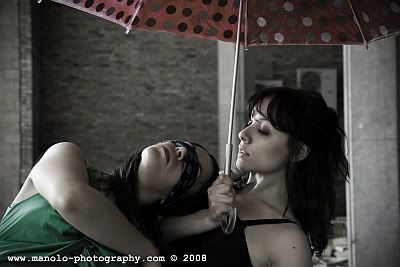
Senza Lamento (Without Lament)
Roundhouse Theatre Studio, Chalk Farm
The Roundhouse is no stranger to large-scale spectacular shows. The epic size of the circular space has housed everything from tribal balladeer Bat for Lashes, Cirque de Soleil's trampolining French men and perhaps the bloodiest renditions of Shakespeare's Histories plays. But one thing most people don't know is that the iconic venue also plays host to a much smaller, more intimate studio. And this studio is set to play a vital role in the current Camden Fringe Festival.
This afternoon, its the turn of Maria Rita Slavi and Nicole Pschetz with their physical-theatre production Senza Lamento (Without Lament), which has just finished its short stint at Merton Abbey Wells as part of 2009's Abbeyfest. Originally created as a site-specific piece in an abandoned house in Italy, the work has been recently adapted for stage and follows an imaginary encounter between two images of the same person; one past and one present. Nicole plays Woman in Dark Blue, a figure who has seemingly lost her sense of identity in the busy city in which she lives. She then meets Woman in Green, Maria, herself in a past form and the two embark on a journey of discovering, punishing and consoling one another.
From the outset, the movement of each performer contains an elegant poise that is at times breathtaking. The piece begins with Woman in Black entering and performing a mournful dance accompanied only by an umbrella, a suitcase and the occasional glimpse of Woman in Green. Nicole manipulates the two props with the utmost ease meaning that they no longer represent simple everyday objects but instead become significant harbourers of memories. The strength and dynamic tension of her body is shown as she wrestles with said umbrella, changing the tempo of her movements in order to make the section appear, at times, as if it is taking place in slow motion. The whole sequence echoes the work of artists such as Charlie Chaplin, Jacques Lecoq or, more recently, James Thierree, an influence that was clearly established during the pair’s training in Corporeal Mime.
There are also traces of Pina Bausch throughout the piece: as the pair repeatedly gag and pull at one another before dropping to the floor, one is distinctly reminded of the danger and risk undertaken by a Bausch performer. The formal dress of both dancers recalls the attire worn in Kontakthof while if the plastic cups Woman in Green frantically moves around towards the performance’s close were replaced by chairs, it would appear as a scene taken straight out of Café Müller.
While there is a sense that this performance was perhaps more powerful in its original form as a site specific work, it still has charm in the close space of the Roundhouse Theatre Studio. And though it is at times confusing with regards to the exact relationship between the two performers, the beauty of the fluid shapes and lines they create on stage means that any ambiguity just adds to the appeal.
Lily Eckhoff





No comments:
Post a Comment